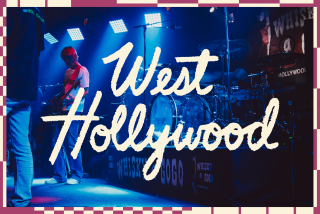A little too glossy
- Share via
Before the first triple-X movie palace could be converted into a children’s theater, before the first brothel could be condemned to make room for a Morgan Stanley office tower, the planners responsible for the recent transformation of Times Square had to make a difficult and enormously consequential decision. They had to decide what made Times Square, well, Times Square. As James Traub puts it in “The Devil’s Playground,” they had to identify which tangible elements “produced the intangible phenomenon that went by the name ‘Times Square.’ ” The answers would be incorporated into new, highly proscriptive zoning laws designed to reverse the decline of a neighborhood that had historically been the cultural center of city life. These laws, first issued in 1982, provided the strict blueprint for the new Times Square: a holographic urban theme park in the center of Manhattan, thronged with glass skyscrapers, flagship mega-stores, theme restaurants and giddy tourists.
For many, the old neighborhood’s defining feature was its historic theaters. Theater industry advocates and philanthropists advanced plans to restore many of the old buildings on 42nd Street, which by the early 1980s had either been abandoned or converted into porno movie theaters. Critics of large-scale urban renewal, like Brendan Gill, considered Times Square the apotheosis of city life; he argued that the entire area must be let alone and cherished in all its “hard-driving, short-tempered, romantic, and hazardous” glory. This was also the plea of the local business owners who, despite the sleaziness of their trade, turned huge profits. Preservation advocates, while lamenting the neighborhood’s decline, fought to preserve the anachronistic low scale of the buildings and storefronts. The Municipal Arts Society, a highly influential force in the redevelopment of Times Square, considered the neighborhood’s concentration of brightly lighted billboards to be its most characteristic feature; they argued that new zoning laws should mandate elaborate luminescent signage on all buildings. Real estate developers looked at the small buildings and saw lucrative high-density office towers -- much as Wile E. Coyote looks at Road Runner and sees a steaming roast chicken. Mayor Ed Koch believed that for Times Square to regain its past glory it was important to build new office towers yet preserve the low scale of the buildings as much as possible and, why not, restore the theaters too. Times Square was widely regarded as the most magical part of New York, but no one could agree why this was so.
Two new histories of Times Square propose their own answers on the occasion of the neighborhood’s centenary this week. (On April 9, 1904, Mayor George B. McClellan Jr. proclaimed that Longacre Square would be renamed Times Square in honor of the New York Times, which had just moved its offices to the triangular plot of land on 42nd Street at the intersection of Broadway and 7th Avenue.) The main players in “The Devil’s Playground” and Anthony Bianco’s “The Ghosts of 42nd Street” are not the preservation societies, government planning commissions or corporate boards that combined to rebuild Times Square but the entrepreneurs, bamboozlers and self-promoters whose ambitions have shaped the neighborhood’s personality for a century. Characters like Oscar Hammerstein, Florenz Ziegfeld, New York Times Publisher Adolph S. Ochs, electric sign pioneer O.J. Gude, porn king Richard Basciano and Playwrights Horizons founder Robert Moss emerge as the true architects of Times Square. Surely the corporations that now inhabit it -- Disney, Time Warner and Viacom, to name a few -- bamboozle and self-promote as rabidly as their predecessors. Yet to many New Yorkers, this one included, there is an eerie sense of finality about the developments that have transformed the neighborhood. Whereas the neighborhood’s gradual decay in the decades after World War II had an organic, if also tragic, inevitability to it, today’s Times Square not only feels like a different neighborhood but a different city. As both books point out, much good has come from this. Still, Times Square has broken from its past, more suddenly and more completely than ever in its history. By comparing the characters of the old Times Square with those of the new, Traub’s and Bianco’s books, taken together, contribute mightily to our understanding of why this break seems so irrevocable.
Traub whisks fluidly through Times Square’s first 50 years in his book’s first section, “The Rise and Fall of Fun.” In a flurry of flying champagne corks and tap-dancing chorus lines, Traub’s narrative careens from lobster palace to roof garden, from opening night at the opulent New Amsterdam Theatre to an after-hours speak-easy run by “the whirling center of the new nocturnal culture,” the faded silent-movie star Texas Guinan. A journalist by trade, Traub gravitates to the accounts of the neighborhood’s most celebrated journalists. The blustering, glamorizing argot favored by Julian Streets, Walter Winchell, Damon Runyon, and A.J. Liebling makes vivid the era’s great showmen and hustlers.
Traub distinguishes between the neighborhood’s phases (“The Times Square of 1915 would have been practically unrecognizable to the denizen of 1905,” he writes at one point) and certainly its architecture and business changed substantially. Most dramatic was the decay of 42nd Street’s majestic theaters. With the advent of sound movies, they became burlesque houses; by the 1960s they had become grindhouses, showing “adults only” B- or C-movie double features around the clock. Crime rates climbed steadily and the sex industry, though always successful in Times Square, became a far more visible presence, on the streets and in the storefronts. Nevertheless, in Traub’s book Times Square until the mid-1960s is an endless parade of merriment -- especially compared with what would follow.
But what exactly did follow? In a 2002 New York Review article about Times Square, Traub described the following era as “a break in the archaeological record.” In his book, he disposes of this lurid record in 10 pages, charting Times Square’s decay primarily through a sampling of crime statistics, quotations from Josh Alan Friedman (author of the ribald “Tales of Times Square”) and a brief analysis of the film “Taxi Driver.” Bianco, by comparison, has 16 pages alone on Martin Hodas, the vending machine operator who brought coin-operated peep shows to 42nd Street. Instead of dwelling on Times Square’s low life, Traub concentrates on the political, economic and legislative processes that transformed Times Square over the last 25 years. Certainly the story of this transformation is an important chapter in the history of Times Square, crucial to our understanding of the neighborhood today, and Traub tells it as fluidly as anyone has. (He manages to condense the lessons of Lynne B. Sagalyn’s comprehensive and beautifully illustrated, if somewhat technical study, “Times Square Roulette.”) Still, while reading “The Devil’s Playground” one waits in vain for a more detailed description of the era in Times Square when the devil played most freely.
Traub’s title would better suit the book by Bianco, a senior writer at Business Week. Though he includes many stories of Times Square’s early luminaries -- his character sketches are more detailed, if less artfully rendered, than Traub’s -- his book reaches its stride when it tells the story behind Hodas’ peep show empire and describes the legal contortions used by the owners of live sex-act clubs to avoid police raids. He emphasizes, moreover, that Times Square’s nadir in the 1970s and 1980s did not lack its heroes.
Chief among these is Moss, whose dream of opening a venue for his off-Broadway theater company led him to the western edge of the Times Square neighborhood in 1974. There he rented an abandoned theater on a block so dilapidated that “it looked like Berlin circa 1946.” His neighbors included the Geisha House, the Tom Cat and the International Body Rub Institute. Ultimately the success of his Playwrights Horizons convinced influential members of New York society that theater could make a comeback in Times Square. Preservationists took note and, as Bianco’s somewhat simplified version of the story goes, launched the effort to remake Times Square.
After crime and pornography have been neatly exorcised, Traub returns to the street and its newest tenants in his book’s final, most powerful section. He tries to engage several executives who have opened mega-stores in the neighborhood, but as might be expected, they say little of interest. (Traub interviews a token chief executive, a “blond, square-jawed executive” of Toys R Us, who gushes that his new flagship store in the middle of Times Square “is a tangible symbol of change.”) Instead, his journalist’s nose leads him to characters like Joseph Sherry, the manager of Howard Johnson’s, the last genuine holdout of old Times Square, and Anita Durst, the avant-garde theater performer and anti-corporate protester who happens to be the daughter of Douglas Durst, the real estate mogul who owns the largest share of the neighborhood’s properties. In the chapter “Plays ‘R’ Us,” he profiles Thomas Schumacher, head of Disney’s theatrical wing, whom Traub likens to legendary Broadway producers David Merrick and David Belasco.
Though this comparison may be a bit farfetched, Traub argues convincingly that many new Times Square characters display the same promotional flair and oddball creativity as their predecessors. The difference is that instead of shaping the spirit of the new Times Square, they must resist being shaped by it. Schumacher struggles to stage exciting, challenging productions within the Disney framework; Anita Durst’s avant-garde theater collective posts billboards urging pedestrians to “Declare Independence From Corporate Rule” but worries about offending her father, their landlord. The electric signage designers see their innovative and technologically ambitious idea for a new sign squashed by a board of investment banking executives.
One thing these books make clear is the difficulty of assigning blame for this new state of affairs -- or even criticizing it sharply. Disney, which has done a remarkable job of restoring the New Amsterdam Theatre to its former glory, is not much more responsible for the neighborhood’s new corporate sheen than the many civic-minded preservation and landmark societies that needed to rely on corporate backing to finance theater restoration. The rehabilitated Times Square is the product of compromise, much of it well-intended. New York was never good at compromise.
More to Read
The biggest entertainment stories
Get our big stories about Hollywood, film, television, music, arts, culture and more right in your inbox as soon as they publish.
You may occasionally receive promotional content from the Los Angeles Times.










